|
Sci-tech
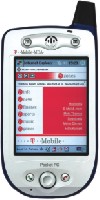 Mobiles
turn into ‘juke boxes’ Mobiles
turn into ‘juke boxes’
Technological
advancement has now made it possible for users to use the
mobile phone as a "jukebox" to download rock music.
According to the New Zealand Herald, due to the trend shown
by many youngsters who regularly keep changing their ringtones
to be in sync with the charts. T-Mobile has recently launched
"ear phones" which will enable users to download
CD-quality tracks and store the tune on the phone for instant
playback. Downloads, however will not require any computer,
MP3 player or iPod.
Laptops
that run on spinach
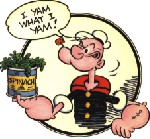 Popeye
might swear by spinach for giving him his power but if scientists
are to be believed, this green vegetable could soon be the
driving force behind laptops. According to Nature, scientists
at the Massachusetts Institute of Technology have created
biologically based solar cells, which convert light into electrical
energy. According to co-creator Marc Baldo these should be
efficient and cheap to manufacture and could even be used
to power laptops, providing a portable source of green energy.
Baldo's team isolated a variety of photosynthetic proteins
from spinach and sandwiched them between two layers of conducting
material. An electrical current was generated when the cell
was exposed to light. The proteins are extracted from the
chloroplasts of spinach leaves, which help plants convert
light into energy. As the reaction proceeds, electrons move
around and create electrical currents. The prototype cells
can generate current for up to 21 days and convert only about
12 percent of the absorbed light energy into electricity. Popeye
might swear by spinach for giving him his power but if scientists
are to be believed, this green vegetable could soon be the
driving force behind laptops. According to Nature, scientists
at the Massachusetts Institute of Technology have created
biologically based solar cells, which convert light into electrical
energy. According to co-creator Marc Baldo these should be
efficient and cheap to manufacture and could even be used
to power laptops, providing a portable source of green energy.
Baldo's team isolated a variety of photosynthetic proteins
from spinach and sandwiched them between two layers of conducting
material. An electrical current was generated when the cell
was exposed to light. The proteins are extracted from the
chloroplasts of spinach leaves, which help plants convert
light into energy. As the reaction proceeds, electrons move
around and create electrical currents. The prototype cells
can generate current for up to 21 days and convert only about
12 percent of the absorbed light energy into electricity.
James
Bond makes life safer for seniors
Scientists
have invented a device, straight out of a James Bond movie,
that uses sensors to raise an alarm automatically. The device
is called Supporting Independently Living Citizens (SILC)
and has been developed by Austrian and British scientists.
It took three years to develop and was sponsored by the EU.
It is a portable device, which is worn on the wearer's wrist
and is ideal for elderly people. It contains sensors and monitoring
devices and automatically triggers an alarm when its wearer
is in life threatening situation. Earlier alarm systems required
a person to push a button to contact an emergency centre because
of which elderly people would hesitate to raise an alarm.
The SILC watch is better because it alerts the emergency centre
before it is too late for a person to push a button on their
own.
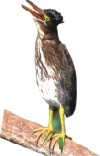 Birds
make better musicians than man Birds
make better musicians than man
Canadian
researchers have found that birds are better at identifying,
classifying, and memorising absolute pitches than both humans
and rats, with humans performing just slightly better than
rats. "It's amazing how dissimilar the results of this
test are when you compare humans and birds. Humans and rats
are weak by any standard and they're just awful when you compare
them to the songbirds," said Dr. Chris Sturdy, a psychology
professor at the University of Alberta. Human beings performed
better in tests of relative pitch, i.e. two sounds played
back to back, providing them a reference to identify another.
But, when asked to comprehend absolute pitch, which is played
alone, they failed to recognise it. Human beings were rewarded
in monetary terms when they memorised or recognised the pitches
that were played for them, whereas the birds and the rats
were given food rewards.
News
for users of electric toothbrushes
The people
who think their latest hi-tech tooth brushes with "rotation-oscillation"
are helping them fight tooth decay and gum diseases must think
again. The largest study of its kind by researchers in UK
found that electric toothbrushes are no better than traditional
brushes at preventing tooth decay and gum disease. They also
found that the reduction of plaque and gum disease was "modest"
while the benefits were "borderline" in the very
long term. Prof Bill Shaw, from Manchester University dental
school's orthodontic department, who led the research, was
quoted in The Telegraph as saying: "People who enjoy
the feel of a powered toothbrush and can afford one may be
assured that it is at least as effective as traditional brushing
and that there is no evidence that it will cause more injuries
to the gum."
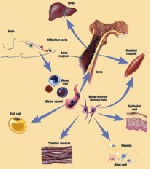 Dried
cells may aid remote medicine Dried
cells may aid remote medicine
In a latest development, researchers
are honing a technique to create dried stem cells that can
be revived just by adding water making the 'instant' cells
an aid in mobile therapies for remote regions or the battlefield.
According to Nature, the theory was based on the fact that
since some stem cells can make fresh bone, muscle or blood,
doctors hope to use them to repair tissues. But, like transplant
organs kept on ice, their shelf life will be limited without
an easy way to store and transport them. Today several scientists
are looking for a way to air-dry cells, comparable to the
technique that turns grapes to raisins. Dried stem cells might
be stored in portable packets that can be ripped open and
their contents mixed with water at the scene of an accident,
says Ann Oliver of University of California. In their latest
advance, Oliver and her colleagues dried out mesenchymal stem
cells, sucked from bone marrow. After drying, less than 40
per cent of the cells was water. When rehydrated immediately
afterwards, up to half grew and divided. Her team soaked the
stem cells in an anti-freeze sugar called trehalose. This
sugar sloshes around in organisms that survive dehydration,
such as brine shrimp, baker's yeast and certain drought-resistant
resurrection plants. Adding a second protective compound called
arbutin boosted cell survival further. What's more, 80-90
per cent of rehydrated cells must be revived before the technique
can be put into practice. It's unclear when it'll come along.
Paintings
help in Visualisation of Text
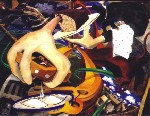 A
new study conducted at the University of Toronto has revealed
that famous writers used various forms of visual images such
as paintings, drawings and photographs to express what language.
Professor Julie LeBlanc studied the diaries, notebooks and
memoirs of such famous writers as Carol Shields, Frida Kahlo,
Roland Barthes, Anny Duperey and Marie-Claire Blais. "Language
is sometimes deficient when it comes to the textual representation
of reality and it's an arbitrary system of communication,
which cannot always express what a novelist or autobiographer
wants to communicate," she said. Even the most talented
of writers (Zola, Baudelaire, Kafka, Grass) have resorted
to creating 'picture books' in the manuscripts of their novels
and diaries to help them, many never meant to be seen by an
author's fans. Published or not, this process can and did
help many famous writers visualise their finished product,
she added. "I think they often came to the conclusion
at some point that they had to call upon another medium, such
as drawing or painting the faces of their characters or using
a photo of an actual geographic location, in order to help
them in the textual representation of these elements,"
she concluded. A
new study conducted at the University of Toronto has revealed
that famous writers used various forms of visual images such
as paintings, drawings and photographs to express what language.
Professor Julie LeBlanc studied the diaries, notebooks and
memoirs of such famous writers as Carol Shields, Frida Kahlo,
Roland Barthes, Anny Duperey and Marie-Claire Blais. "Language
is sometimes deficient when it comes to the textual representation
of reality and it's an arbitrary system of communication,
which cannot always express what a novelist or autobiographer
wants to communicate," she said. Even the most talented
of writers (Zola, Baudelaire, Kafka, Grass) have resorted
to creating 'picture books' in the manuscripts of their novels
and diaries to help them, many never meant to be seen by an
author's fans. Published or not, this process can and did
help many famous writers visualise their finished product,
she added. "I think they often came to the conclusion
at some point that they had to call upon another medium, such
as drawing or painting the faces of their characters or using
a photo of an actual geographic location, in order to help
them in the textual representation of these elements,"
she concluded.
Source:
Webindia123.com /Google.com
Copyright (R)
thedailystar.net 2004
|
